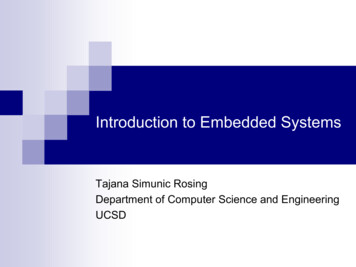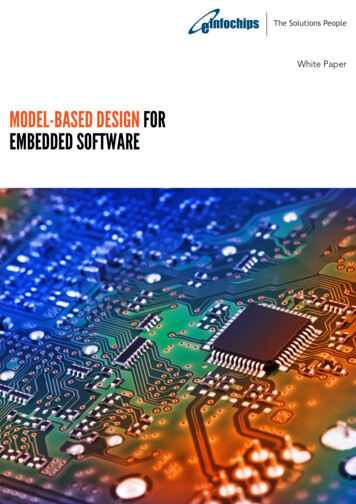
Transcription
CSE 466 – Software for Embedded Systemsn Instructor:q Bruce Hemingwayn n n q q CSE 464, Office Hours: 1:30-2:30 p.m., Mondayor whenever the door is openbruceh@cs.washington.eduTeaching Assistants:Shuowei Li and Hanchuan LiCSE 466Introduction1CSE 466 – Software for Embedded Systemsn Class Meeting Times and Location:q q n Lectures: EEB 045, MWF 12:30-1:20Labs: CSE 003, Tuesday, Thursday, 2:30-5:20Examsq q CSE 466Midterm: Wednesday, October 29, EEB 045, 12:30-1:20Final: Thursday, December 11, 2014, 830-1020, CSE 003Introduction21
CSE 466 – Software for Embedded Systemsn Grading Policyq q n There will be two exams, as shown on the class schedule.Lab reports: Demo usually required, sometimes questionsRatios:q q q q Lab: 50%Exams total: 20%Homework: 10% (reports)Class Participation: 20%CSE 466Introduction3Recommended Textbook:The Definitive Guide to ARM Cortex -M3 and Cortex -M4Processors, Third EditionBy Joseph YiuNewnes; 3 edition (November 1,2013)U Bookstore doesn’t have it.CSE 466Introduction42
Embedded systemsCSE 466Introduction5What are Embedded Systems?Anything that uses a microprocessor but isn't a general-purpose computer– PDAs– Set-top boxes– Televisions– Video Games– Refrigerators– Cars– Planes– Elevators– Remote Controls– Alarm Systems The user “sees” a smart (special-purpose) system as opposed to the computerinside the system “how does it do that?” “it has a computer inside it!” “oh! BTW, it does not or cannot run Windows or MacOS!”– the end-user typically does not or cannot modify or upgrade the internalsn 3
What Are You Going to Learn? Hardware– I/O, memory, busses, devices, control logic, interfacing hardwareto software Software– Lots of C and assembly, device drivers, low levelreal-time issues, scheduling,– Concurrency: interrupts Software/Hardware interactions– Where is the best place to put functionality hardwareor software?– What are the costs: performance, memory requirements (RAM and/or ROM) Integration of hardware and software courses– Programming, logic design, architecture,– Algorithms, mathematics and common senseWhere Could You End Up?Automotive systems– perhaps designing and developing “drive-by-wire” systems-- self-driving vehicles Telecommunications Consumer electronics– cellular phones, MP3 devices, integrated cellular/tablet/kitchen sink– Set-top boxes and HDTV– Home appliances– Internet appliances your washer will be on the internet more than you are! Defense and weapon systems Process control– gasoline processing, chemical refinement Automated manufacturing– Supervisory Control and Data Acquisition (SCADA) Space applications– Satellite communicationsn 4
Goals of the CourseHigh-Level Goals1. Understand the scientific principles and concepts behind embedded systems,and2. Obtain hands-on experience in programming embedded systems.By the end of the course, you should be able to Understand the "big ideas" in embedded systems Obtain direct hands-on experience on both hardware and software elementscommonly used in embedded system design. Understand the basics of embedded system application concepts such as signalprocessing and feedback control Understand, and be able to discuss and communicate intelligently about– embedded processor architecture and programming– I/O and device driver interfaces to embedded processors with networks,multimedia cards and disk drives– OS primitives for concurrency, timeouts, scheduling, communication andsynchronizationn The Big Ideas HW/SW Boundary Non processor centric view of architecture Bowels of the operating software– specifically, basic real-time operation with interrupts– Concurrency Real-world design– performance vs. cost tradeoffs Analyzability– how do you “know” that your drive-by-wire system will function correctly? Application-level techniques– signal processing, control theory– semaphores, locks, atomic sections5
What is an Embedded System? Computer purchased as part of some other piece of equipment– Typically dedicated software (may be user customizable)– Often replaces previously electromechanical components– Often no “real” keyboard– Often limited display or no general purpose display device But, every system is unique there are always exceptionsCPU: An All-Too-Common View of Computing Measured by:– Performance6
An Advanced Computer Engineer's View Measured by: Performance Compilers matter too.An Enlightened Computer Engineer's View Measured by: Performance, CostCompilers & OS matters7
An Embedded Computer Designer's View Measured by: Cost, I/O connections, Memory Size,PerformanceAn Embedded Control System Designer's View Measured by:Cost, Time to market, Cost, Functionality, Cost & Cost.8
A Customer View– Reduced Cost– Increased Functionality– Improved Performance– Increased Overall DependabilityWhy Are Embedded Systems Different?Four General Categories of Embedded Systems General Computing– Applications similar to desktop computing, but in an embedded package– Video games, settop boxes, wearable computers, automatic tellers– Tablets, Phablets Control Systems– Closed loop feedback control of real time system– Vehicle engines, chemical processes, nuclear power, flight control Signal Processing– Computations involving large data streams– Radar, Sonar, video compression Communication & Networking– Switching and information transmission– Telephone system, Internet– Wireless everything9
Typical Embedded System Constraints Small Size, Low Weight– Handheld electronics– Transportation applications weight costs money Low Power– Battery power for 8 hours (laptops often last only 2 hours)– Limited cooling may limit power even if AC power available Harsh environment– Heat, vibration, shock– Power fluctuations, RF interference, lightning– Water, corrosion, physical abuse Safety critical operation– Must function correctly– Must not function incorrectly Extreme cost sensitivity– .05 adds up over 1,000,000 unitsEmbedded System Design World-ViewA complex set of tradeoffs: Optimize for more than just speed Consider more than just the computer Take into account more than just initial product designMulti-Discipline Electronic Hardware Software Mechanical Hardware Control Algorithms Humans Society/InstitutionsxMultiPhase Requirements Design Manufacturing Deployment Logistics RetirementxMultiObjective Dependability Affordability Safety Security Scalability Timeliness10
Embedded System Designer Skill Set Appreciation for multidisciplinary nature of design– Both hardware & software skills– Understanding of engineering beyond digital logic– Ability to take a project from specification through production Communication & teamwork skills– Work with other disciplines, manufacturing, marketing– Work with customers to understand the real problem being solved– Make a good presentation; even better write trade rag'' articles And, by the way, technical skills too.– Low-level: Microcontrollers, FPGA/ASIC, assembly language, A/D,D/A– High-level: Object oriented Design, C/C , Real Time OperatingSystems– Meta-level: Creative solutions to highly constrained problems– Likely in the future: Unified Modeling Language, embeddednetworksClass logistics – see course webn n n n n n au/Class structureBusiness mattersGradingSyllabusWhat we’ll be doingCSE 466Introduction2211
Class structuren Lectureq q q n Labq q n Work leading to implementation of a final projectLab reports due prior with 30 minutes of start of next labsectionExamsq q n Mondays: about the week’s labClosely linked to laboratory assignmentsCover main concepts, introduce laboratory problemsTwo, based on lecture, lab, and datasheet readingOpen datasheets, open notesFinal demoq During last class time – participation requiredCSE 466Introduction23Business Mattersn Lecture notes will be on line after class (links onCalendar page)n You pick lab partner assignmentsn Sign up for CSE466 mailing list (soon)CSE 466Introduction2412
Gradingn Lab reports:q q q q q n Demonstration(s) requiredBrief answers to questions embedded in assignmentSometimes hand-in codeDo with your partnerBoth build hardwareDistribution:q q q q Labs: 50%Exams: 20%Homework: 10%Class Participation: 20%CSE 466Introduction25CSE466 Lab Contentn Arm Cortex M4 processorq q q n Resourcesq q q q q q n Begin with basics and buildDo with your lab partner; both will build hardwareYou can work alone at homeFreescale Arm Processor320x240 Color LCD displaySwitch, potentiometerAccelerometer with gyroscopeTri-color LEDLearn how to interface various devicesFinal projectq q q CSE 466Heart-rate monitor– a mini ECGLCD display of heart traceMeasure heart rate, basic arhythmia detectionIntroduction2613
Freescale MK20DX256VLH7 processorCSE 466Introduction27CSE 466Introduction2814
CSE466 LabsFinal Project – Using the Teensy 3.1Build a Heart Rate Monitorn n CSE 466Introduction29Assignment for Friday:Review the K20 Sub-Family Reference ManualMK20DX256 Manual (8.0M PDF), for Teensy 3.1 (This manualhas all the useful programing info)n q Chapter 2: Introduction and Functional ModulesDownload 66/14au/pdfs/K20P64M72SF1RM.pdf(link is on the Resources page.)CSE 466Introduction3015
2. Obtain hands-on experience in programming embedded systems. By the end of the course, you should be able to Understand the "big ideas" in embedded systems Obtain direct hands-on experience









